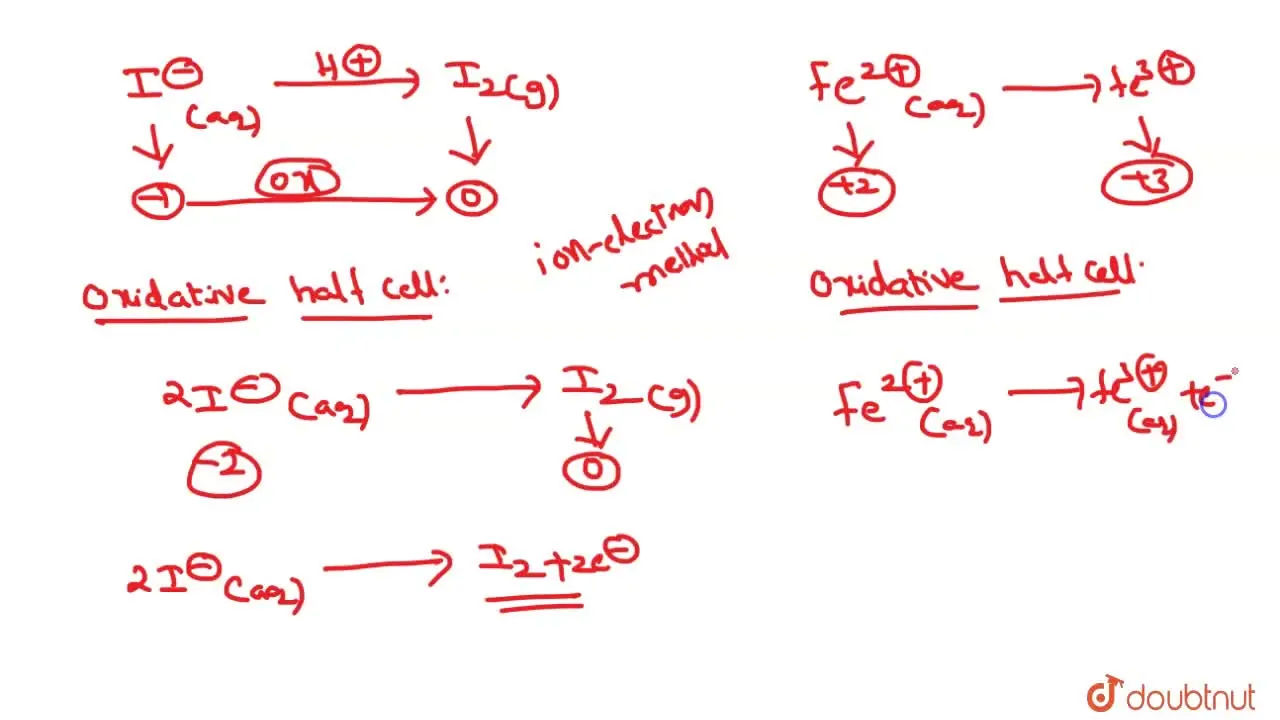Balance the conversions :
I−(aq)H+−−→I2(g) and Fe2+(aq)H+−−→Fe3+(aq)Solution in Telugu
Step by step video & image solution for Balance the conversions : I^(-)(aq) overset(H^(+))rarr I_(2)(g) and Fe^(2+)(aq) overset(H^(+))rarr Fe^(3+)(aq) by Chemistry experts to help you in doubts & scoring excellent marks in Class 12 exams.
Related Playlists
- BOOK - AAKASH SERIESCHAPTER - REDOX REACTONSEXERCISE - Exercise 4.1.43videos
REDOX REACTONS
- BOOK - AAKASH SERIESCHAPTER - REDOX REACTONSEXERCISE - Questions For Descriptive Answers27videos
REDOX REACTONS
- BOOK - AAKASH SERIESCHAPTER - REDOX REACTONSEXERCISE - Exercise - 4.1.211videos
REDOX REACTONS
- BOOK - AAKASH SERIESCHAPTER - PROTEINS AND NUCLEIC ACIDS EXERCISE - PRACTICE SHEET - 430videos
PROTEINS AND NUCLEIC ACIDS
- BOOK - AAKASH SERIESCHAPTER - REVISION EXERCISE EXERCISE - COMPLEX COMPOUNDS47videos
REVISION EXERCISE
Similar Questions
Write examples of extraction of metals using reducing agents.
22:26View SolutionHow are no electron transfer reactions different from redox reactions ?
01:24View SolutionWhat is oxidation number ? Write notation.
02:03View SolutionAnti bodies are ………..
02:49View SolutionIn which of the following complexes the metal ion is in zero oxidation state ?
04:02View SolutionBalance the following rebox reactions by ion electron method: a. MnO_(4)^(Θ)(aq)+I^(Θ)(aq) rarr MnO_(2)(s)+I_(2)(s) (in basic medium) b. MnO_(4)^(Θ)(aq)+SO_(2)(g) rarr Mn^(2+)(aq)+HSO_(4)^(Θ)(aq) (in acidic solution) c. H_(2)O_(2)(aq)+Fe^(2+)(aq) rarr Fe^(3+)(aq)+H_(2)O(l) (in acidic solution) d. Cr_(2)O_(7)^(2-)+SO_(2)(g) rarr Cr^(3+)(aq)+SO_(4)^(2-)(aq) (in acidic solution)
View Solution__ Sn^(2+) (aq)+__ NO_(3)^(-) (aq)+__ H^(+) (aq) rarr __ Sn^(4+) (aq) +__ NO(g)+ __ H_(2)O What is the coefficent for H^(+) (aq) when the equation above is balanced correctly with the smallesr interger coefficients?
03:26View SolutionGiven the standard oxidation potentials
Fe+0.4V−−−→Fe2+(aq.)−0.8V−−−→Fe3+(aq.)
Fe+0.9V−−−→Fe(OH)20.6V−−→Fe(OH)3
It is easier to oxidise Fe^(2+) " to " Fe^(3+)inView SolutionUsing standard electrode potentials, predict the reaction, if any, that ocurs between Fe3+(aq)andI−(aq)
E∘Fe3+(aq)/Fe2+(aq)=0.77V,E∘I2/2I−(aq)=0.54V04:02View SolutionFe2+(aq.)+Cr2O2−7+H+→Fe3+(aq.)+Cr3+
05:39View SolutionConstruct galvanic cells for the given spontaneous radox reactions. (i) Zn(s)+2HCl(aq)rarrZnCl_(2)(aq)+H_(2)("g, 1 atm") (ii) Cl_(2)("g, 1 atm")+2I^(-)(aq)rarr I_(2)(aq)rarr I_(2)(s)+2Cl^(-)(aq) (iii) (1)/(2)H_(2)("g, 1 atm")+(1)/(2)Cl_(2)("g, 1 atm") rarr HCl (aq) (iv) Fe^(2+)(aq)+Ce^(4+)(aq)rarrFe^(3+)(aq)+Ce^(3+)(aq) (v) H_(2)("g, 1 atm")+AgCl(s)rarr Ag(s)+HCl(aq)
03:10View SolutionComplete the following : (a) Fe^(2+)(aq)+MnO_(4)^(-)(aq)overset(H^(+))rarr (b) MnO_(4)^(-)+S_(2)O_(3)^(2-)overset(H_(2)O)rarr , (c ) Cr_(2)O_(7)^(2-)+S_(2)O_(3)^(2-)overset(H^(+))rarr
01:55View SolutionWhat is ‘A’ in the following reaction?
2Fe3+(aq)+Sn2+(aq)→2Fe2+(aq)+A07:39View SolutionFe2+(aq.)+Cr2O2−7+H+→Fe3+(aq.)+Cr3+
04:45View SolutionBalance the following equation by the half reaction method. Fe^(2+) (aq) + Cr_2O_7^(2-) (aq) +H^(+) (aq) rarr Fe^(3+) (aq) + Cr^(3+) (aq) +H_2O (I)
01:19View Solution


